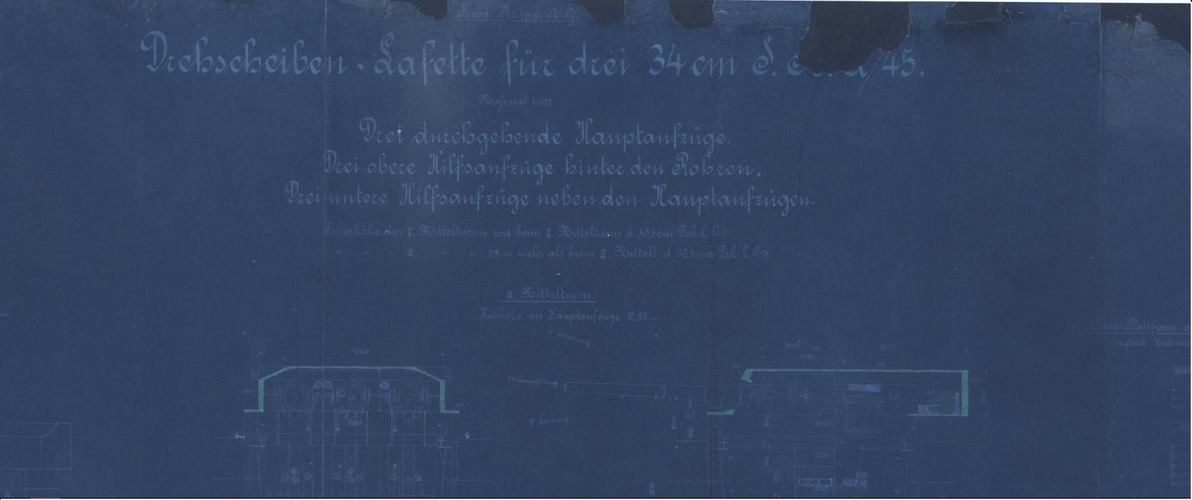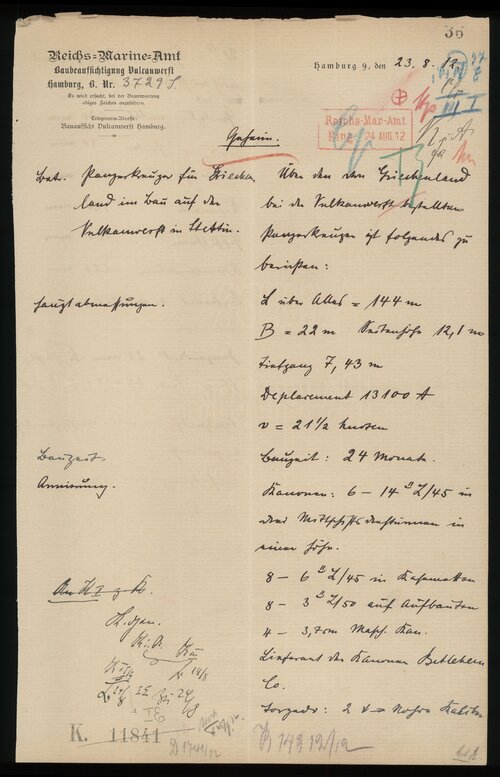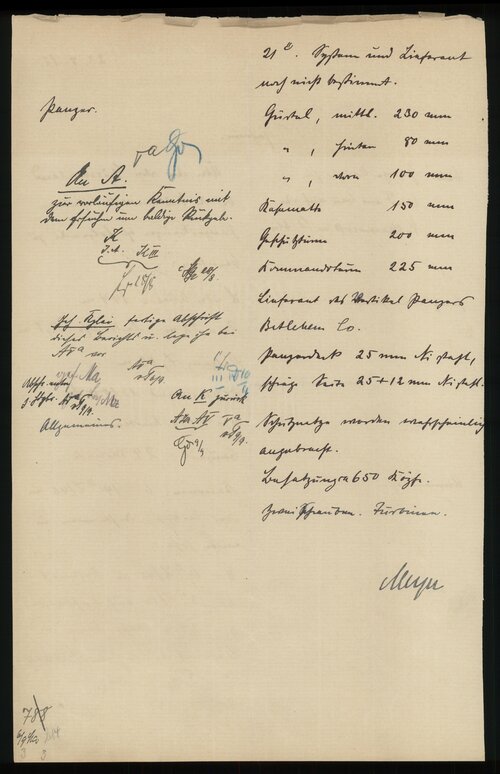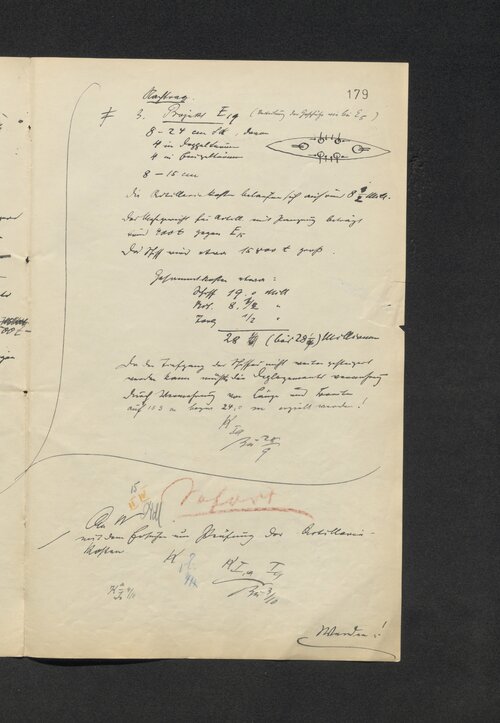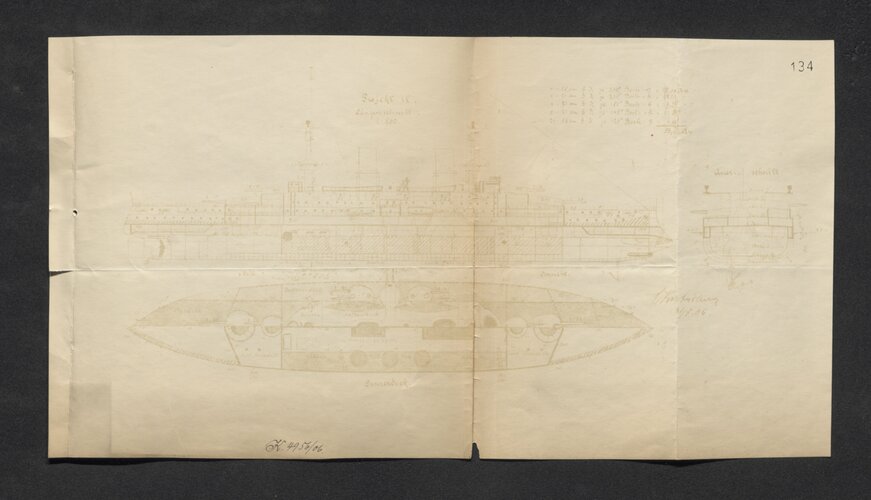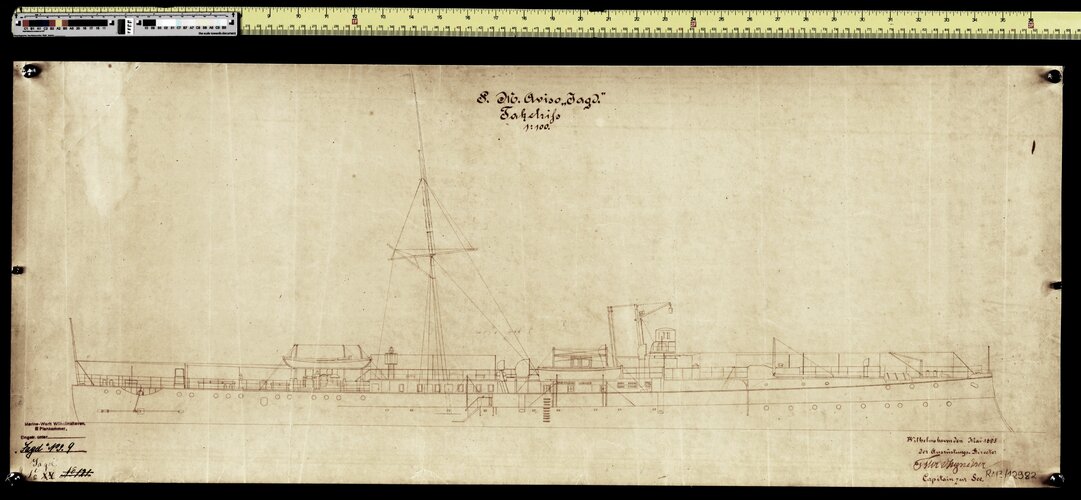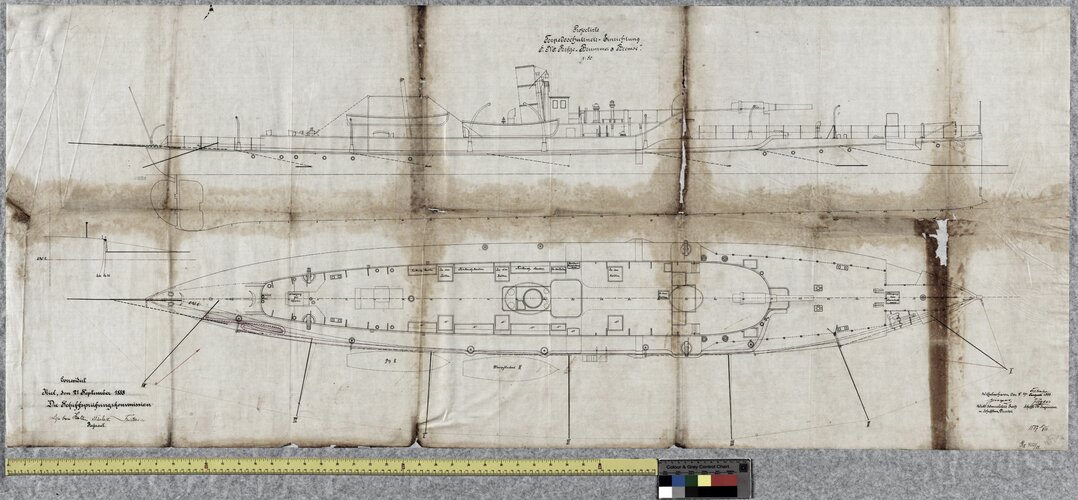You are using an out of date browser. It may not display this or other websites correctly.
You should upgrade or use an alternative browser.
You should upgrade or use an alternative browser.
Kaiserliche Marine - Imperial German Navy Ship Plans/Discussion
- Thread starter _Sarcasticat_
- Start date
_Sarcasticat_
Die Katze.
- Joined
- 16 April 2020
- Messages
- 364
- Reaction score
- 351
Quick update.
I recalled that I had downloaded a bunch of WWI Kaiserliche Marine ship plans. Not too much is available, but it's there. This not the most recent plans, but what was available a few months ago that I had on-hand. They have now been uploaded.
They include plans for:
- Mackensen-class Battlecruiser
- Scharnhorst-class Armored Cruiser
- Yorck-class Armored Cruiser
- Bayern-class Battleship
- Coln-class Light Cruiser
- Derfflinger-class Battlecruiser
- Ersatz Yorck-class Battlecruiser
- Konig-class Battleships
- Konigsberg-class Light Cruiser
- Madgeburg-class Light Cruiser
- Konig-class Battleships
- Moltke-class Battlecruiser
And a few others.
I recalled that I had downloaded a bunch of WWI Kaiserliche Marine ship plans. Not too much is available, but it's there. This not the most recent plans, but what was available a few months ago that I had on-hand. They have now been uploaded.
They include plans for:
- Mackensen-class Battlecruiser
- Scharnhorst-class Armored Cruiser
- Yorck-class Armored Cruiser
- Bayern-class Battleship
- Coln-class Light Cruiser
- Derfflinger-class Battlecruiser
- Ersatz Yorck-class Battlecruiser
- Konig-class Battleships
- Konigsberg-class Light Cruiser
- Madgeburg-class Light Cruiser
- Konig-class Battleships
- Moltke-class Battlecruiser
And a few others.
Last edited:
Both Bayern half-sisters Sachsen and Württemberg have also been digitalized, you can at least see their machinery layout, armor deck, turrets, upper deck etc, though i haven't able to find their diesel engines on the hull yet to compares with Baden and Bayern.
The suppose schlachtschiff "O" is schlachtschiff "G" hull btw given the plan name.Schlachtschiff O
From "German export designs from private shipyards", here's probably the characteristics of pre-design battleship Salamis, if anyone can decrypt the rest i will very appreciated, according to other texts German call them "panzerkreuzer" (Armored cruiser equivalent term to British "battlecruiser").
Attachments
Last edited:
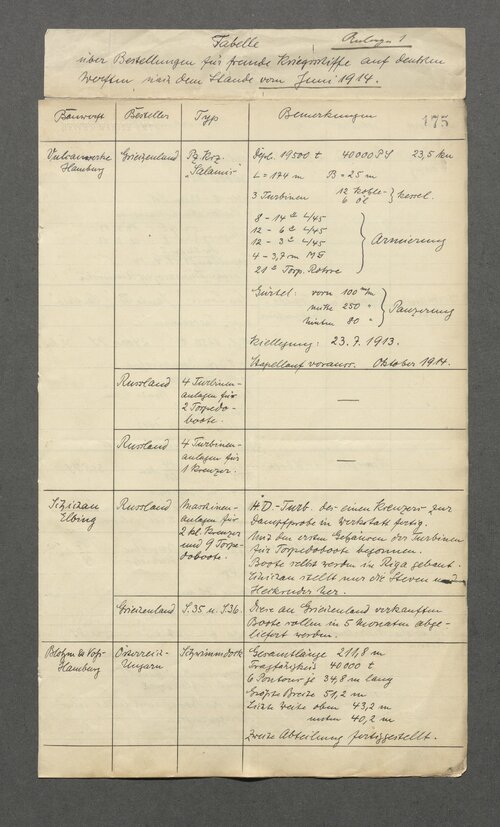

Country in the lists ranging from Greece (finalized Salamis), Russia (AG Vulcan built two light cruisers, with their engines and machinery), Austro-Hungarian? (looks like a 40000t floating dock), Argentina (4 large torpedo boats), Norway, Dutch (4 small torpedo boats), Japan (no clue, but it mentioned diesel, possibly diesel engines).
Roodbaard1958!
ACCESS: Confidential
- Joined
- 26 December 2019
- Messages
- 97
- Reaction score
- 130
Alexi, what is the exact source for both scans? The four torpedoboats mentioned to be built by the Vulkanwerft, Stettin on account of the Netherlands were never delivered. In Dutch service they would become the Z1-4. Instead all four were commissioned in the German navy as V105-108 and three survived the First World War. V10 became Polish Mazur, V106 handed over to Brazil and sold to England, broken up in 1920?, V107 sunk after hitting a mine on 8 May 1915 and V108 became Polish Kaszub. The Dutch shipyards Nederlandsche Scheepsbouw Mij, Amsterdam laid down in 1915 built as replacement the Z1-4.View attachment 731534View attachment 731535
Country in the lists ranging from Greece (finalized Salamis), Russia (AG Vulcan built two light cruisers, with their engines and machinery), Austro-Hungarian? (looks like a 40000t floating dock), Argentina (4 large torpedo boats), Norway, Dutch (4 small torpedo boats), Japan (no clue, but it mentioned diesel, possibly diesel engines).
Last edited:
Roodbaard1958!
ACCESS: Confidential
- Joined
- 26 December 2019
- Messages
- 97
- Reaction score
- 130
From "German export designs from private shipyards", here's probably the characteristics of pre-design battleship Salamis, if anyone can decrypt the rest i will very appreciated, according to other texts German call them "panzerkreuzer" (Armored cruiser equivalent term to British "battlecruise
Alexi what is the correct source for both scan?From "German export designs from private shipyards", here's probably the characteristics of pre-design battleship Salamis, if anyone can decrypt the rest i will very appreciated, according to other texts German call them "panzerkreuzer" (Armored cruiser equivalent term to British "battlecruiser").
The text is dealing with the Salamis called a panzerkreuzer.
Lenght over all 144 metres.
Beam 22 metres,
Depth in hold (?) 12,1 metres
Draught 7,43 metres
displacement 13,100 tons
sped 21.5 knots
Building time 24 months
3x2-14cm L/45 (turrets)
8-6 cm L/45 casemates
8-3cm L/50 on aufbauten, rough translation of aufbau=construction
4-3,7cm
Bethelem Co delivered guns?
Remaing text I did not read no time, is dealing with the armour belt =fore 100-center 230-aft 80mm
casemates 150mm
gun turrets 200 mm
conning tower 225 mm
armour delivered by Bethlehem Co?
Last edited:
RM 3/1097 (the scan numbers attached in the image, pg 341 and 342 for the export tables) and thank you for the decryption.Alexi what is the correct source for both scans
00-PureEvil-00
ACCESS: Restricted
- Joined
- 5 September 2021
- Messages
- 43
- Reaction score
- 65
@Roodbaard1958!
P.S. How the hell does one quote/reply to a post which is entirely a quote itself?... Maybe my browser is too old, but normal quoting just doesn't work for me.
These calibers are in inches, not centimetres. So, that will be 3×2 356-mm/45, 8× 152-mm/50, and 8× 76-mm/50. The only caliber given in centimetres is the last one, 3,7-cm — these are, most likely, saluting guns.3x2-14cm L/45 (turrets)
8-6 cm L/45 casemates
8-3cm L/50 on aufbauten, rough translation of aufbau=construction
P.S. How the hell does one quote/reply to a post which is entirely a quote itself?... Maybe my browser is too old, but normal quoting just doesn't work for me.
_Sarcasticat_
Die Katze.
- Joined
- 16 April 2020
- Messages
- 364
- Reaction score
- 351
Well done. As memory serves, measurements done on German plans are also in Imperial. Weird, as I had thought they'd converted entirely to metric decades before.@Roodbaard1958!
These calibers are in inches, not centimetres. So, that will be 3×2 356-mm/45, 8× 152-mm/50, and 8× 76-mm/50. The only caliber given in centimetres is the last one, 3,7-cm — these are, most likely, saluting guns.
P.S. How the hell does one quote/reply to a post which is entirely a quote itself?... Maybe my browser is too old, but normal quoting just doesn't work for me.
I just use the Reply function. I suspect that would work?
Data tables of armored cruiser "E" or "Grosse Kreuzer 1906" (aka SMS Blücher), there's some interesting bit about her preliminaries from other pages but i can't read since most these are hand writing, note "D.T" mean double turret and "E.T" mean single turret.

Note both E6 and E7 have 17cm gun secondaries.
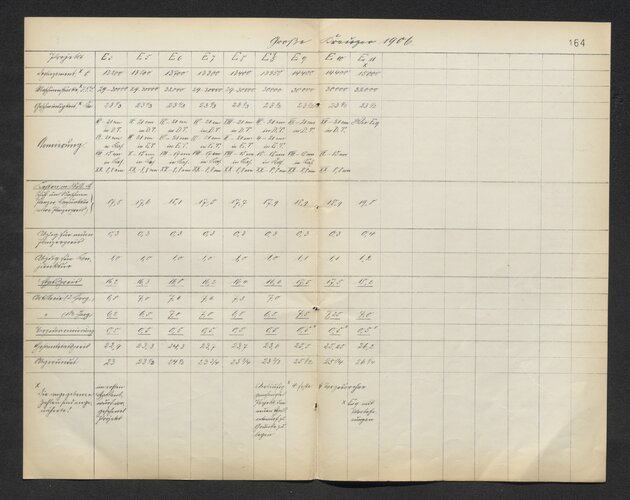
Note both E6 and E7 have 17cm gun secondaries.
Last edited:
thanksFrom Erich Gröner "Die deutschen Kriegsschiffe 1815-1945" vol.1 :
Roodbaard1958!
ACCESS: Confidential
- Joined
- 26 December 2019
- Messages
- 97
- Reaction score
- 130
Alexi, what is the corrrect source for this scan?Data tables of armored cruiser "E" or "Grosse Kreuzer 1906" (aka SMS Blücher), there's some interesting bit about her preliminaries from other pages but i can't read since most these are hand writing, note "D.T" mean double turret and "E.T" mean single turret.
View attachment 732799
Note both E6 and E7 have 17cm gun secondaries.
RM 3-357 page 0331 and 0361, the scans numbers should be in the file image when you hover/click on it.Alexi, what is the corrrect source for this scan?
Roodbaard1958!
ACCESS: Confidential
- Joined
- 26 December 2019
- Messages
- 97
- Reaction score
- 130
Thx!RM 3-357 pagina 0331 en 0361, de scannummers zouden in de bestandsafbeelding moeten staan als u erop zweeft/klikt.
Unrelated, I found a couple of improved Deustchland-class pre-dreadnought plans from RM 3 some months ago but never post here, these are the part of 1906 naval programs presumably. There are no data on hull dimensions (except Projekt IX haven't read it yet), only design requirements at 16000 tons and top speed of 19 knots. Total of 10 projects (Projekt I - X), they only have above/top view of the hull plans sadly. Here's the all-big gun projects, the rest are mixed caliber with 28cm, 24cm, 21cm, 19cm and 17cm types.
"Projekt I" - 6x28cm/L40 (3x2), 8x17cm and 24x8.8cm in casemate.
"Projekt II" - 6x28cm/L40 (2x2, 2x1), 4x21cm (4x1) and 24x8.8cm in deck mounts and casemate.
"Projekt III" - 10x28cm/L40 (2x2, 2x1 in turrets and 4x1 in casemate) and 24x8.8cm in deck mounts and casemate.
"Projekt VI" - 12x28cm/L40 (4x2 in turrets, 4x1 in casemate) and 24x8.8cm in deck mounts and casemate.
One notable mixed caliber pre-dreadnought type was "Projekt IX" have 2x2 28cm but armed to the teeth with 16x21cm in twin turrets!one can be describe as "German Lord Nelson".
"Projekt I" - 6x28cm/L40 (3x2), 8x17cm and 24x8.8cm in casemate.
"Projekt II" - 6x28cm/L40 (2x2, 2x1), 4x21cm (4x1) and 24x8.8cm in deck mounts and casemate.
"Projekt III" - 10x28cm/L40 (2x2, 2x1 in turrets and 4x1 in casemate) and 24x8.8cm in deck mounts and casemate.
"Projekt VI" - 12x28cm/L40 (4x2 in turrets, 4x1 in casemate) and 24x8.8cm in deck mounts and casemate.
One notable mixed caliber pre-dreadnought type was "Projekt IX" have 2x2 28cm but armed to the teeth with 16x21cm in twin turrets!one can be describe as "German Lord Nelson".
Attachments
Last edited:
Hi, Alexi,Unrelated, I found a couple of improved Deustchland-class pre-dreadnought plans from RM 3 some months ago but never post here, these are the part of 1906 naval programs presumably. There are no data on hull dimensions (except Projekt IX haven't read it yet), only design requirements at 16000 tons and top speed of 19 knots. Total of 10 projects (Projekt I - X), they only have above/top view of the hull plans sadly. Here's the all-big gun projects, the rest are mixed caliber with 28cm, 24cm, 21cm, 19cm and 17cm types.
"Projekt I" - 6x28cm/L40 (3x2), 8x17cm and 24x8.8cm in casemate.
"Projekt II" - 6x28cm/L40 (2x2, 2x1), 4x21cm (4x1) and 24x8.8cm in deck mounts and casemate.
"Projekt III" - 10x28cm/L40 (2x2, 2x1 in turrets and 4x1 in casemate) and 24x8.8cm in deck mounts and casemate.
"Projekt VI" - 12x28cm/L40 (4x2 in turrets, 4x1 in casemate) and 24x8.8cm in deck mounts and casemate.
One notable mixed caliber pre-dreadnought type was "Projekt IX" have 2x2 28cm but armed to the teeth with 16x21cm in twin turrets!one can be describe as "German Lord Nelson".
Can you provide the exact document number? According to your description, these designs do not seem to belong to any "official design history" - neither the research of D.Nottelmann or A.Grießmer, nor the Kurrent font files that have been digitized. When the discussion about rises to 16,000 tons displacement, the turret used in the design is no longer an old design (L/40, although L/45 was still called Drh.L. C/01 at the time). Judging from the more "Italian" secondary armament of P.IX, it is possible that it was a study directed by Wilhelm II.
I hope I can provide some help.View attachment 731534View attachment 731535
Country in the lists ranging from Greece (finalized Salamis), Russia (AG Vulcan built two light cruisers, with their engines and machinery), Austro-Hungarian? (looks like a 40000t floating dock), Argentina (4 large torpedo boats), Norway, Dutch (4 small torpedo boats), Japan (no clue, but it mentioned diesel, possibly diesel engines).
1. In this table, Vulcan built for Russia the turbine equipments (Turbinenanlagen) for two torpedo boats and a cruiser, not the ships themselves - the latter later gave rise to the proposal to build a new mine cruiser (i.e. SMS Brummer); Schichau's shipyard in Danzig was responsible for two new small cruisers (the future Pillau class), and its shipyard in Elbing was responsible for their machinery equipment;
2. To be precise, what was built for Argentina was a torpedo boat destroyer (Torpedozerstörer), which may not be the same as the "official" large torpedo boat in terms of reference relationship;
3. What Vulcan built for Japan was a DC adjustable transformer (Unisteuerbaren Transformator für Dieselmaschine eines Zerstörers) for the diesel machine (probably generator) of a destroyer, not built a diesel engine; this destroyer was built in Yarrow (der bei Yarrow im Bau ist).
I'm currently writing about Tirpitz Fleet Law and the Wilhelm II Fast battleship race, and I'll try to help you out when I have some free time.
- Joined
- 22 January 2006
- Messages
- 4,222
- Reaction score
- 2,038
No. It would be a good idea.Are there any threads on the forum or other sites discussing Germany's unfinished naval program in WWI like this thread?
- Joined
- 6 September 2006
- Messages
- 4,841
- Reaction score
- 9,490
This thread has been split out from KM Ship Plans Discussion
Other related sections are:
KM Naval Armament Plans and Discussion
Link to _Sarcasticat_ file store on this topic:
 drive.google.com
drive.google.com
Other related sections are:
KM Naval Armament Plans and Discussion
Link to _Sarcasticat_ file store on this topic:
Germany - Google Drive
 drive.google.com
drive.google.com
Pirate Pete
ACCESS: Secret
- Joined
- 25 July 2007
- Messages
- 351
- Reaction score
- 586
Some pages from a book I copied from some years ago in my then local Reference Library:
Deutsche Grosskampshiffe 1915-1918, Sonderausgabe: Die Entwicklung der Typenfrage im Ersten Weltkrieg. Mit Schiffstypen-Darstellungen. By Friedrich Forstmeier and Siegfried Breyer.
Apologies for relatively poor quality but it was in the days before Scanners and it was a 'wet paper' type photocopier/xerox machine.
Deutsche Grosskampshiffe 1915-1918, Sonderausgabe: Die Entwicklung der Typenfrage im Ersten Weltkrieg. Mit Schiffstypen-Darstellungen. By Friedrich Forstmeier and Siegfried Breyer.
Apologies for relatively poor quality but it was in the days before Scanners and it was a 'wet paper' type photocopier/xerox machine.
Attachments
Similar threads
-
-
Kriegsmarine - KM Naval Armament Plans/Discussion
- Started by _Sarcasticat_
- Replies: 293
-
Kriegsmarine Naval What-If Ships
- Started by _Sarcasticat_
- Replies: 20
-
-
Foreign Dockyards and Naval Bases (Unbuilt/Unrealised)
- Started by Pirate Pete
- Replies: 0

